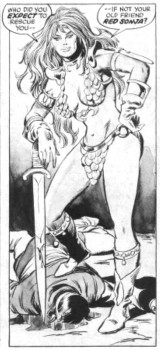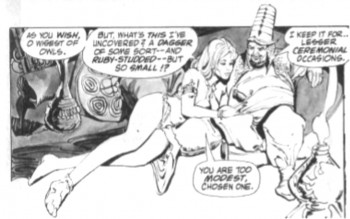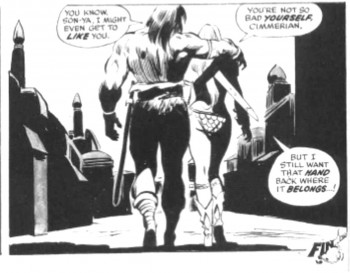In Defense of Red Sonja: The Chain Mail Bikini
 After only two appearances in Conan the Barbarian (issues 23 and 24), Red Sonja was already on her way to becoming a fan favorite. A strong, intelligent woman with the courage of Conan, if not his strict moral code (or upper body strength). Her dress sense (a chain mail tunic and red shorts) provided ease of movement and showed just enough skin to be sexy without being exploitive.
After only two appearances in Conan the Barbarian (issues 23 and 24), Red Sonja was already on her way to becoming a fan favorite. A strong, intelligent woman with the courage of Conan, if not his strict moral code (or upper body strength). Her dress sense (a chain mail tunic and red shorts) provided ease of movement and showed just enough skin to be sexy without being exploitive.
So where did the chain mail bikini come from?
Before the Internet, fan art was published mostly in fanzines or pin-up pages in comics. Artist Esteban Maroto was the first to draw Red Sonja in her now-famous bikini and, having nowhere else to publish it, mailed it to Conan writer/editor Roy Thomas. The visual was so striking that, when she next made an appearance, artist John Buscema drew her in the same outfit. Furthermore, Maroto was hired to draw the back-up story in that same issue. And to make it a hat-trick, a third artist (none other than Boris Vallejo) painted the cover art with the metallic swimwear.
The issue where all this took place would have been iconic anyway. Savage Sword of Conan 1 premiered in August 1974. The popularity of Conan the Barbarian had made the publication of a second Conan book just good business sense. To give you an idea of just how popular the character was, Marvel wouldn’t get around to publishing two Spider-Man titles until 1976.
Of course, Savage Sword would promise to be far from more-of-the-same. Its format as an over-sized black-and-white publication classified it as a magazine rather than a comic book. “So what?” you may ask. In 1974, comics were still heavily regulated by the Comics Code Authority. There was only so much violence (and sex) that could be shown in Conan the Barbarian. But as a ‘magazine’, Savage Sword of Conan could show as much violence (and, eventually, nudity) as Marvel dared. And as the series went on, they dared a lot.
Chronologically, the back-up story (simply titled, “Red Sonja”) precedes the main piece, so let’s start there. It opens shortly after the events of “The Song of Red Sonja” wrapped up, with Sonja bringing the mystic doodad (a serpent crown that turns into a demonic snake if you handle it wrong) to her employer. Apparently, he gave it to his son-in-law as part of a dowry and later thought better of it, so sent Sonja to steal it back under cover of war. In return for the crown, he promises her a handsome but unspecified reward.
This really should be in a sword-for-hire handbook somewhere: never work for an unspecified reward. Especially when your employer is chuckling as he says it. You’re going to get screwed upon completion of the mission.
Sure enough, the “reward” is a place in the king’s harem. Being clearly outnumbered in the king’s palace, Sonja surrenders and allows herself to be bathed, but not without abusing her bathers. And no, the bathers aren’t men. They’re other women in the harem who probably got suckered into the palace the same as her. So Red Sonja spends a page being pissed off about having to take a bath. And she is made to wear a flimsy silk harem girl outfit, which would be much more degrading if she hadn’t stripped out of something far more revealing to put it on.
So a dolled-up Sonja is presented to the king (or sultan, I’m not real clear on his title) and simpers appropriately. If Red Sonja tells you, “My appearance, then, is pleasing to you, O Blessed of Tarim,” with fluttering eye-lids, you are about to die. When she asks, oh so innocently, if he might dismiss the bodyguard from the room so they might have some “privacy”, even he knows that’s a bad idea.

But the moron was carrying a knife in his belt. And he let Sonja within caressing distance. And when she slipped the knife out of his belt, he asked for her to give it back to him. If Red Sonja takes your knife and you tell her to give it to you … you have no business being surprised.
The best part of the story is when the bodyguard attacks her. He’s not avenging his lord’s death. He’s just pissed that Sonja killed his boss, because now he’s out of a job. And who can’t relate to that? Needless to say, Sonja makes sure that the bodyguard never collects unemployment.
(Just as a side-note, there are several references to the bodyguard being an albino, which seems a pointless detail since this story was originally printed in a black-and-white magazine.)
The main story, “Curse of the Undead-Man,” takes place some time afterwards, beginning with Conan walking through the alleys of Zamora’s City of Thieves, minding his own business. He’s nearly knocked over by a gang of robed men fleeing a gang of robbers. Seeing that there’s some grave misunderstanding between all present, he asks for everyone to calm down and explain the situation.
No.
Not really.
He just starts beating the crap of both gangs. And he very nearly wipes them all out before he trips and falls over something. Fortunately, he’s saved by recurring guest star, Red Sonja (making this the third time she saves him). It turns out that the item he tripped over was the mummified finger of a dismembered wizard whom the apprentices were trying to re-assemble. Just let that sink in for a second before reading on.

One re-constructed wizard and a bar fight later, Conan and Red Sonja are at the wizard’s castle, driving off a pair of demons and cutting up the undead wizard once again. This time, it’s Conan who saves Sonja (from Yog-Sothoth and Gol-Goroth, demon half-brothers who live in a pit). And the two walk off together as friends, but not lovers.
In the back-up story, there’s another mention of Red Sonja’s vow that “no man ever shall touch her, save one who’s defeated her in battle,” along with the addendum, “at that rate, she’ll be a maiden when she dies.” It’s the first hint of tragedy in the character. This may not be a woman who has set high standards as much as a woman who’s locked off a part of herself. We still have no idea why she would make such a vow, but we know that she takes it quite seriously and that the prospect of becoming a harem slave is therefore exceptionally distasteful.
However, in “Undead-Man,” we see a friendship form between Sonja and Conan. So we can surmise that her vow was not taken simply out of a hatred for men. Her admonitions that the Cimmerian should watch his hands are somewhat playful at this stage, not because she secretly wants him, but because she trusts him not to try forcing himself on her.
And so, even as the look of Red Sonja degenerates to fan-service cheesecake, her character becomes something deeper than just female Conan. Despite the implied challenge in her vow, we don’t see a woman who’s just waiting for the right man to drive all those silly notions of independence from her pretty little head. Instead, we see a passionate woman, capable of deep friendships and deep hatreds, who refuses to define herself through sex even as she bares an increasing amount of skin.
Images are taken from Savage Sword of Conan 1 (Marvel, artists John Buscema and Estabon Moroto)
Next Week: The Vow
Good piece, Michael! But I have to nitpick. Marvel technically had a second Spider-Man book going. Actually, they’d had two, at two different times. The first Spectacular Spider-Man comic was a magazine that ran briefly in 1968, the first issue being black-and-white and the second in colour. It only lasted the two issues. But then in 1972 Marvel began publishing Marvel Team-Up, which was effectively a Spider-Man title where the ol’ web-head met a different Marvel character every month. Marvel Two-in-One, the same idea but starring the Thing, kicked off in January of 1974, so the blue-eyed idol of millions had a second book as well. Also, Dracula Lives!, a black-and-white spin-off of Tomb of Dracula, began to be published in 1973.
None of which detracts from your main point: Conan was really popular for Marvel, and Savage Sword was a real success. If memory serves, it was the longest-lasting of all the Marvel magazines. I never understood why Marvel allowed the rights to Conan to lapse, especially once they’d integrated the Hyborian Age into their continuity.
Hey, Matthew, I completely forgot about Marvel Team-Up, which is really kind of unbelievable since Spider-Man would eventually team up with Red Sonja in that same book.
To answer Matthew’s question, the reason Marvel let the rights to Conan lapse was due to a combination of shortsightedness and cheapness. After Roy Thomas left Marvel Conan and Savage Sword went through a revolving door of writers, artists and editors with nobody ever being ever to quite match Thomas. Circulation slowly dropped and the property was eventually discontinued. I imagine they intended to do a re-boot later but the company went through an austerity phase during one of it’s bankruptcies during the 90’s and they let the rights go probably with the idea that they would pick them up again later. They did the same thing to all of their licensed properties. In the case of the REH properties Dark Horse quickly snatched them up and the rest is history.